Research Report: Assessing Credit Card Impact on Consumer Spending
VerifiedAdded on 2023/06/05
|7
|1503
|311
Report
AI Summary
This marketing research report investigates the impact of credit cards on consumer spending, employing an inductive research approach and a mixed-methods design. A survey, distributed via the internet, targets young credit card users in Australia who enjoy shopping. Simple random probability sampling is used to select 150 participants, and data is analyzed using statistical assessment techniques, including mean, mode, median, regression, and correlation, with the aid of MS-Excel. The research aims to increase knowledge about the effects of credit cards on spending, understand their effectiveness among users in reputable companies, and create awareness about the impact of credit card usage on personal savings, ultimately providing insights into the pros and cons of credit card use for purchases.
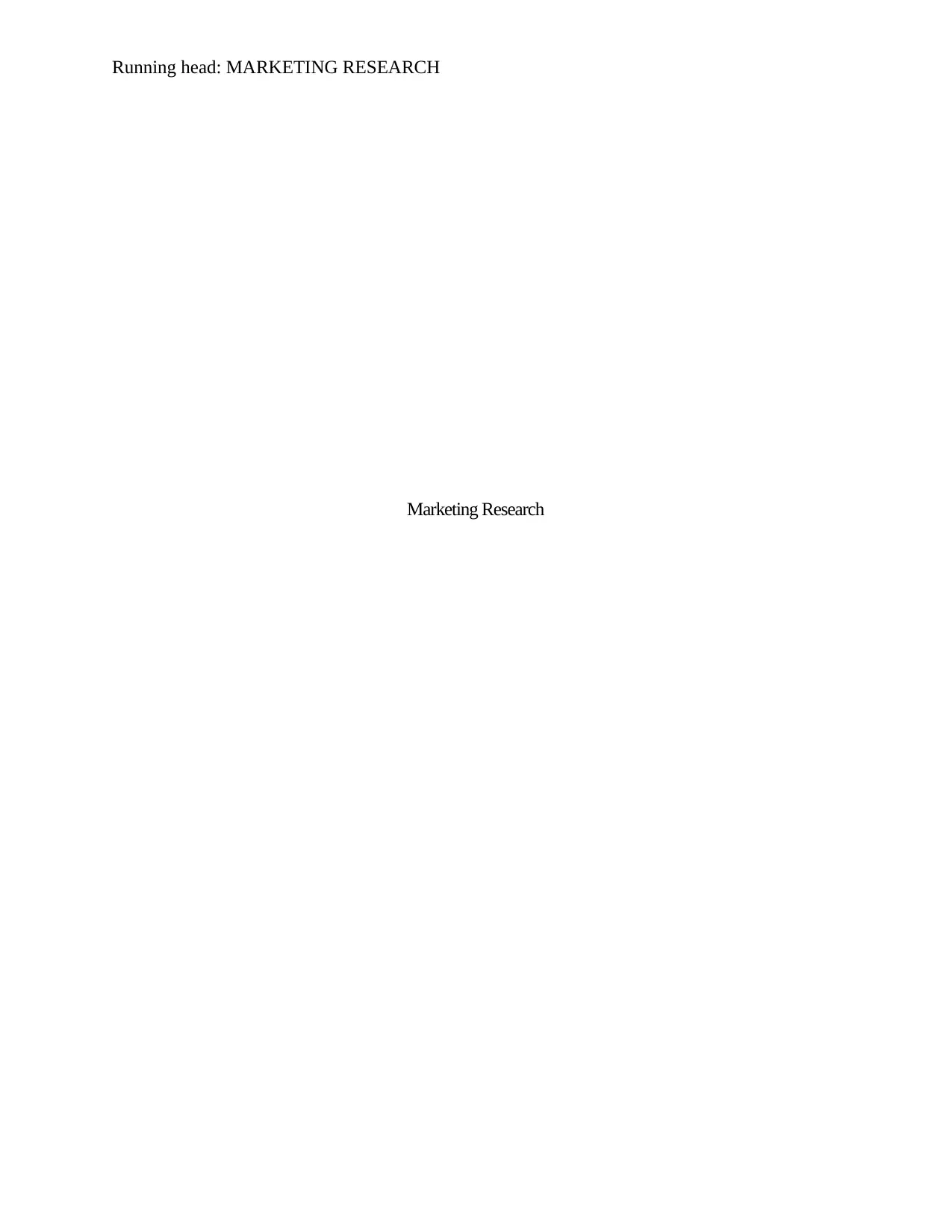
Running head: MARKETING RESEARCH
Marketing Research
Marketing Research
Paraphrase This Document
Need a fresh take? Get an instant paraphrase of this document with our AI Paraphraser
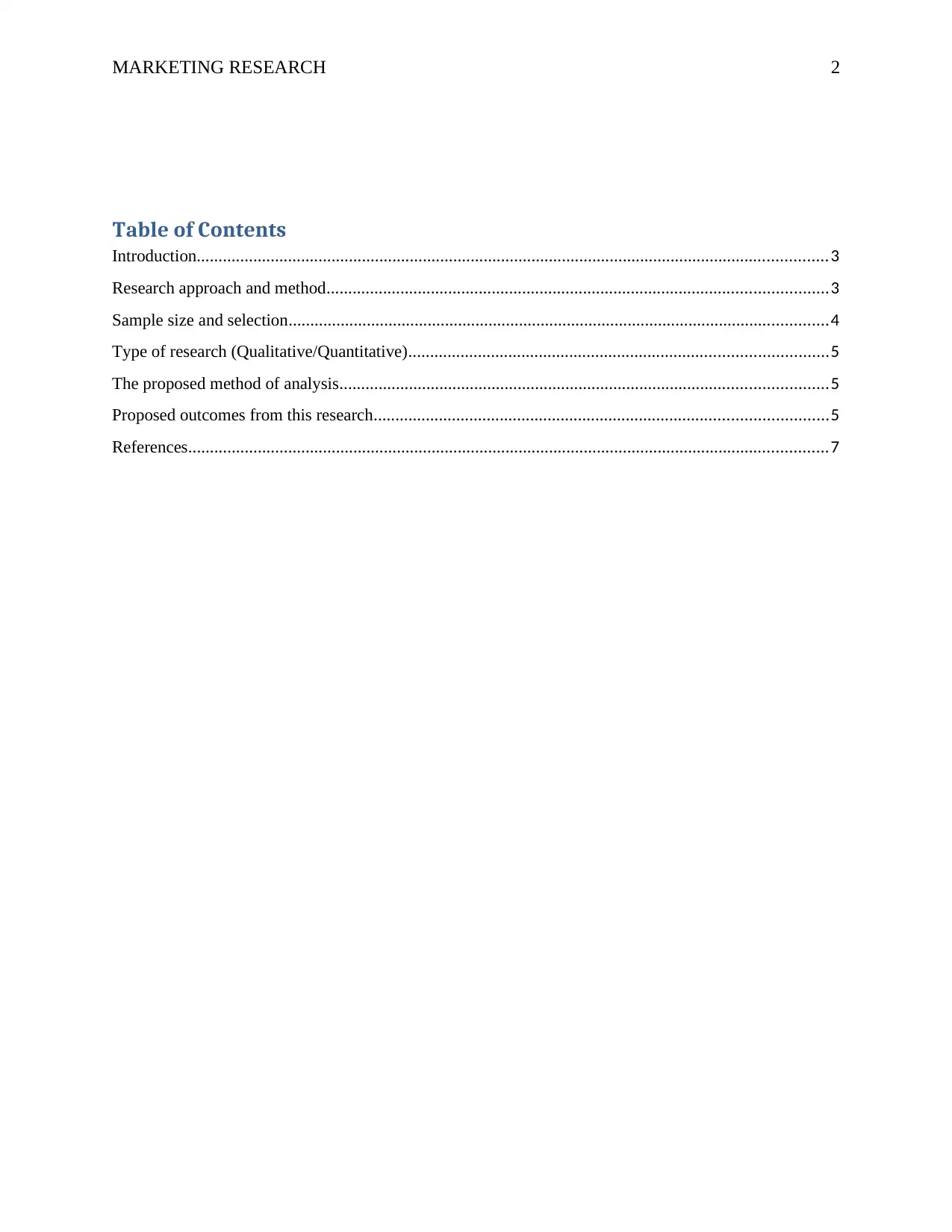
MARKETING RESEARCH 2
Table of Contents
Introduction.................................................................................................................................................3
Research approach and method...................................................................................................................3
Sample size and selection............................................................................................................................4
Type of research (Qualitative/Quantitative)................................................................................................5
The proposed method of analysis................................................................................................................5
Proposed outcomes from this research........................................................................................................5
References...................................................................................................................................................7
Table of Contents
Introduction.................................................................................................................................................3
Research approach and method...................................................................................................................3
Sample size and selection............................................................................................................................4
Type of research (Qualitative/Quantitative)................................................................................................5
The proposed method of analysis................................................................................................................5
Proposed outcomes from this research........................................................................................................5
References...................................................................................................................................................7
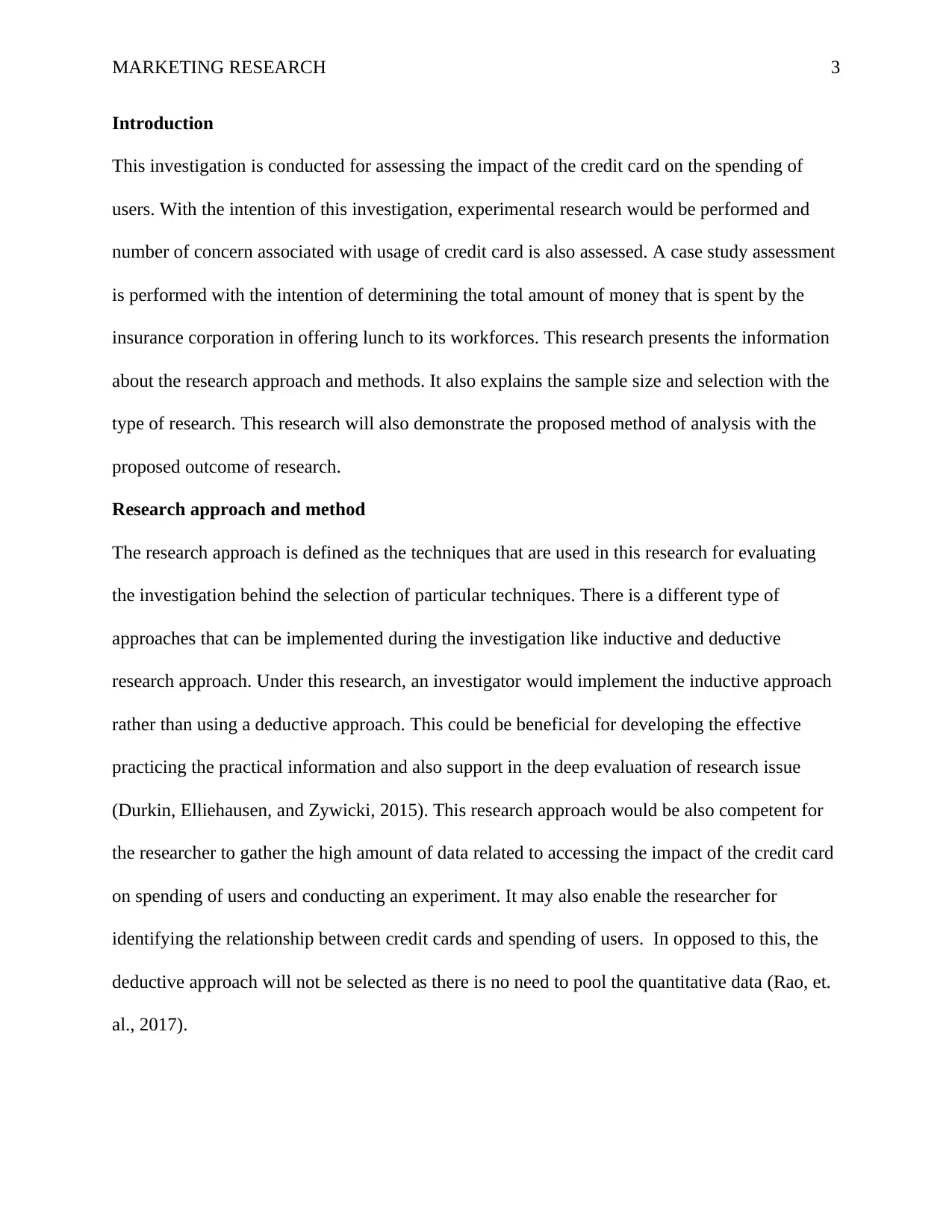
MARKETING RESEARCH 3
Introduction
This investigation is conducted for assessing the impact of the credit card on the spending of
users. With the intention of this investigation, experimental research would be performed and
number of concern associated with usage of credit card is also assessed. A case study assessment
is performed with the intention of determining the total amount of money that is spent by the
insurance corporation in offering lunch to its workforces. This research presents the information
about the research approach and methods. It also explains the sample size and selection with the
type of research. This research will also demonstrate the proposed method of analysis with the
proposed outcome of research.
Research approach and method
The research approach is defined as the techniques that are used in this research for evaluating
the investigation behind the selection of particular techniques. There is a different type of
approaches that can be implemented during the investigation like inductive and deductive
research approach. Under this research, an investigator would implement the inductive approach
rather than using a deductive approach. This could be beneficial for developing the effective
practicing the practical information and also support in the deep evaluation of research issue
(Durkin, Elliehausen, and Zywicki, 2015). This research approach would be also competent for
the researcher to gather the high amount of data related to accessing the impact of the credit card
on spending of users and conducting an experiment. It may also enable the researcher for
identifying the relationship between credit cards and spending of users. In opposed to this, the
deductive approach will not be selected as there is no need to pool the quantitative data (Rao, et.
al., 2017).
Introduction
This investigation is conducted for assessing the impact of the credit card on the spending of
users. With the intention of this investigation, experimental research would be performed and
number of concern associated with usage of credit card is also assessed. A case study assessment
is performed with the intention of determining the total amount of money that is spent by the
insurance corporation in offering lunch to its workforces. This research presents the information
about the research approach and methods. It also explains the sample size and selection with the
type of research. This research will also demonstrate the proposed method of analysis with the
proposed outcome of research.
Research approach and method
The research approach is defined as the techniques that are used in this research for evaluating
the investigation behind the selection of particular techniques. There is a different type of
approaches that can be implemented during the investigation like inductive and deductive
research approach. Under this research, an investigator would implement the inductive approach
rather than using a deductive approach. This could be beneficial for developing the effective
practicing the practical information and also support in the deep evaluation of research issue
(Durkin, Elliehausen, and Zywicki, 2015). This research approach would be also competent for
the researcher to gather the high amount of data related to accessing the impact of the credit card
on spending of users and conducting an experiment. It may also enable the researcher for
identifying the relationship between credit cards and spending of users. In opposed to this, the
deductive approach will not be selected as there is no need to pool the quantitative data (Rao, et.
al., 2017).
⊘ This is a preview!⊘
Do you want full access?
Subscribe today to unlock all pages.

Trusted by 1+ million students worldwide
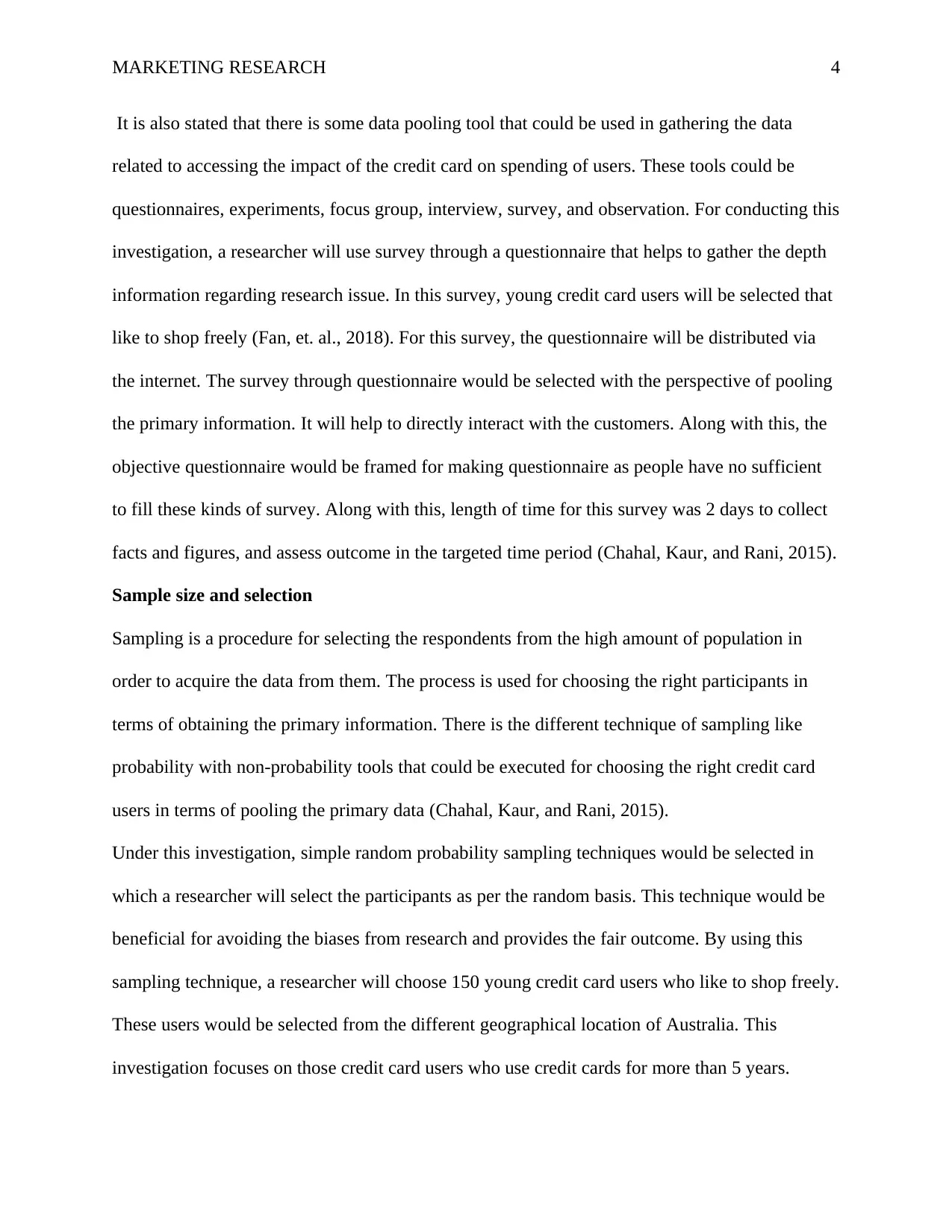
MARKETING RESEARCH 4
It is also stated that there is some data pooling tool that could be used in gathering the data
related to accessing the impact of the credit card on spending of users. These tools could be
questionnaires, experiments, focus group, interview, survey, and observation. For conducting this
investigation, a researcher will use survey through a questionnaire that helps to gather the depth
information regarding research issue. In this survey, young credit card users will be selected that
like to shop freely (Fan, et. al., 2018). For this survey, the questionnaire will be distributed via
the internet. The survey through questionnaire would be selected with the perspective of pooling
the primary information. It will help to directly interact with the customers. Along with this, the
objective questionnaire would be framed for making questionnaire as people have no sufficient
to fill these kinds of survey. Along with this, length of time for this survey was 2 days to collect
facts and figures, and assess outcome in the targeted time period (Chahal, Kaur, and Rani, 2015).
Sample size and selection
Sampling is a procedure for selecting the respondents from the high amount of population in
order to acquire the data from them. The process is used for choosing the right participants in
terms of obtaining the primary information. There is the different technique of sampling like
probability with non-probability tools that could be executed for choosing the right credit card
users in terms of pooling the primary data (Chahal, Kaur, and Rani, 2015).
Under this investigation, simple random probability sampling techniques would be selected in
which a researcher will select the participants as per the random basis. This technique would be
beneficial for avoiding the biases from research and provides the fair outcome. By using this
sampling technique, a researcher will choose 150 young credit card users who like to shop freely.
These users would be selected from the different geographical location of Australia. This
investigation focuses on those credit card users who use credit cards for more than 5 years.
It is also stated that there is some data pooling tool that could be used in gathering the data
related to accessing the impact of the credit card on spending of users. These tools could be
questionnaires, experiments, focus group, interview, survey, and observation. For conducting this
investigation, a researcher will use survey through a questionnaire that helps to gather the depth
information regarding research issue. In this survey, young credit card users will be selected that
like to shop freely (Fan, et. al., 2018). For this survey, the questionnaire will be distributed via
the internet. The survey through questionnaire would be selected with the perspective of pooling
the primary information. It will help to directly interact with the customers. Along with this, the
objective questionnaire would be framed for making questionnaire as people have no sufficient
to fill these kinds of survey. Along with this, length of time for this survey was 2 days to collect
facts and figures, and assess outcome in the targeted time period (Chahal, Kaur, and Rani, 2015).
Sample size and selection
Sampling is a procedure for selecting the respondents from the high amount of population in
order to acquire the data from them. The process is used for choosing the right participants in
terms of obtaining the primary information. There is the different technique of sampling like
probability with non-probability tools that could be executed for choosing the right credit card
users in terms of pooling the primary data (Chahal, Kaur, and Rani, 2015).
Under this investigation, simple random probability sampling techniques would be selected in
which a researcher will select the participants as per the random basis. This technique would be
beneficial for avoiding the biases from research and provides the fair outcome. By using this
sampling technique, a researcher will choose 150 young credit card users who like to shop freely.
These users would be selected from the different geographical location of Australia. This
investigation focuses on those credit card users who use credit cards for more than 5 years.
Paraphrase This Document
Need a fresh take? Get an instant paraphrase of this document with our AI Paraphraser
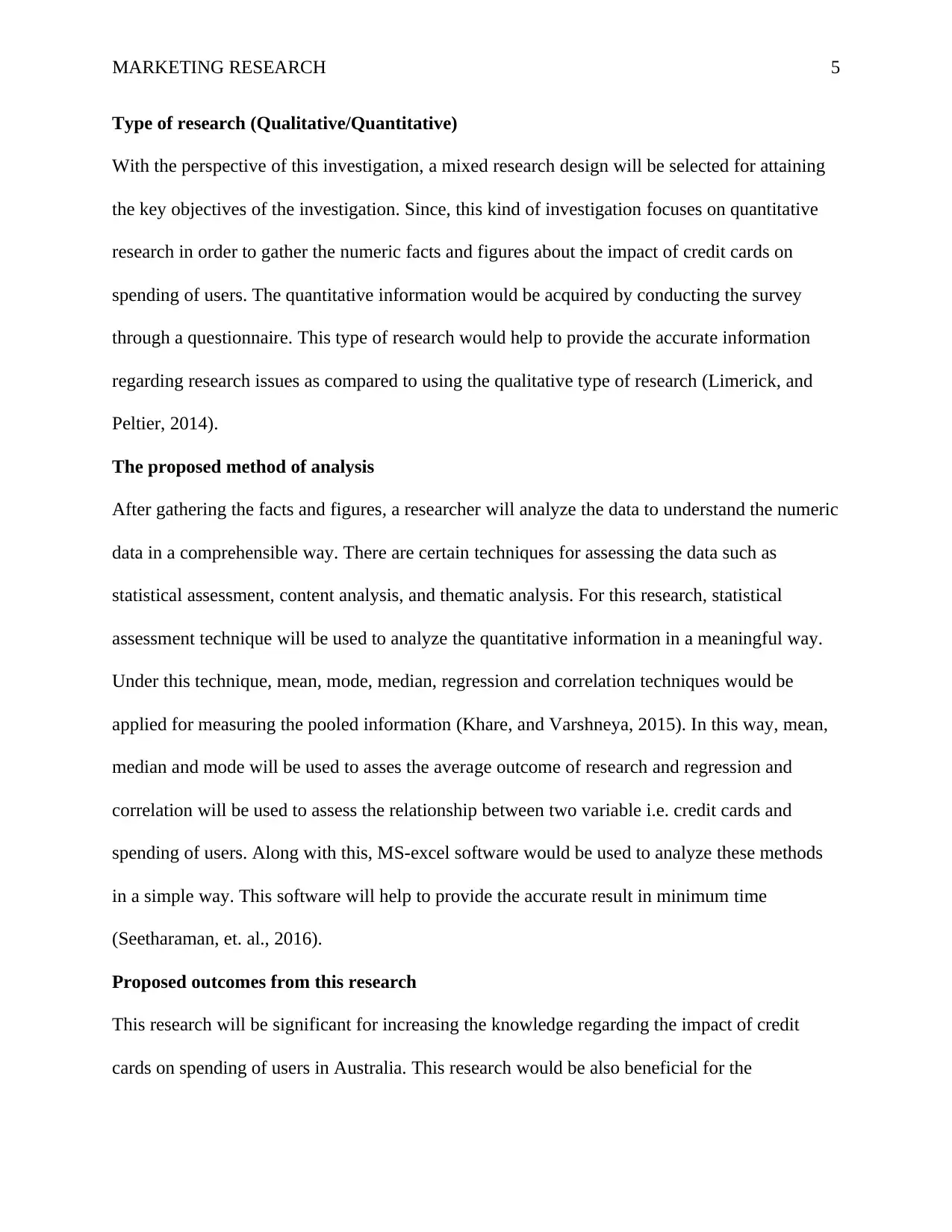
MARKETING RESEARCH 5
Type of research (Qualitative/Quantitative)
With the perspective of this investigation, a mixed research design will be selected for attaining
the key objectives of the investigation. Since, this kind of investigation focuses on quantitative
research in order to gather the numeric facts and figures about the impact of credit cards on
spending of users. The quantitative information would be acquired by conducting the survey
through a questionnaire. This type of research would help to provide the accurate information
regarding research issues as compared to using the qualitative type of research (Limerick, and
Peltier, 2014).
The proposed method of analysis
After gathering the facts and figures, a researcher will analyze the data to understand the numeric
data in a comprehensible way. There are certain techniques for assessing the data such as
statistical assessment, content analysis, and thematic analysis. For this research, statistical
assessment technique will be used to analyze the quantitative information in a meaningful way.
Under this technique, mean, mode, median, regression and correlation techniques would be
applied for measuring the pooled information (Khare, and Varshneya, 2015). In this way, mean,
median and mode will be used to asses the average outcome of research and regression and
correlation will be used to assess the relationship between two variable i.e. credit cards and
spending of users. Along with this, MS-excel software would be used to analyze these methods
in a simple way. This software will help to provide the accurate result in minimum time
(Seetharaman, et. al., 2016).
Proposed outcomes from this research
This research will be significant for increasing the knowledge regarding the impact of credit
cards on spending of users in Australia. This research would be also beneficial for the
Type of research (Qualitative/Quantitative)
With the perspective of this investigation, a mixed research design will be selected for attaining
the key objectives of the investigation. Since, this kind of investigation focuses on quantitative
research in order to gather the numeric facts and figures about the impact of credit cards on
spending of users. The quantitative information would be acquired by conducting the survey
through a questionnaire. This type of research would help to provide the accurate information
regarding research issues as compared to using the qualitative type of research (Limerick, and
Peltier, 2014).
The proposed method of analysis
After gathering the facts and figures, a researcher will analyze the data to understand the numeric
data in a comprehensible way. There are certain techniques for assessing the data such as
statistical assessment, content analysis, and thematic analysis. For this research, statistical
assessment technique will be used to analyze the quantitative information in a meaningful way.
Under this technique, mean, mode, median, regression and correlation techniques would be
applied for measuring the pooled information (Khare, and Varshneya, 2015). In this way, mean,
median and mode will be used to asses the average outcome of research and regression and
correlation will be used to assess the relationship between two variable i.e. credit cards and
spending of users. Along with this, MS-excel software would be used to analyze these methods
in a simple way. This software will help to provide the accurate result in minimum time
(Seetharaman, et. al., 2016).
Proposed outcomes from this research
This research will be significant for increasing the knowledge regarding the impact of credit
cards on spending of users in Australia. This research would be also beneficial for the
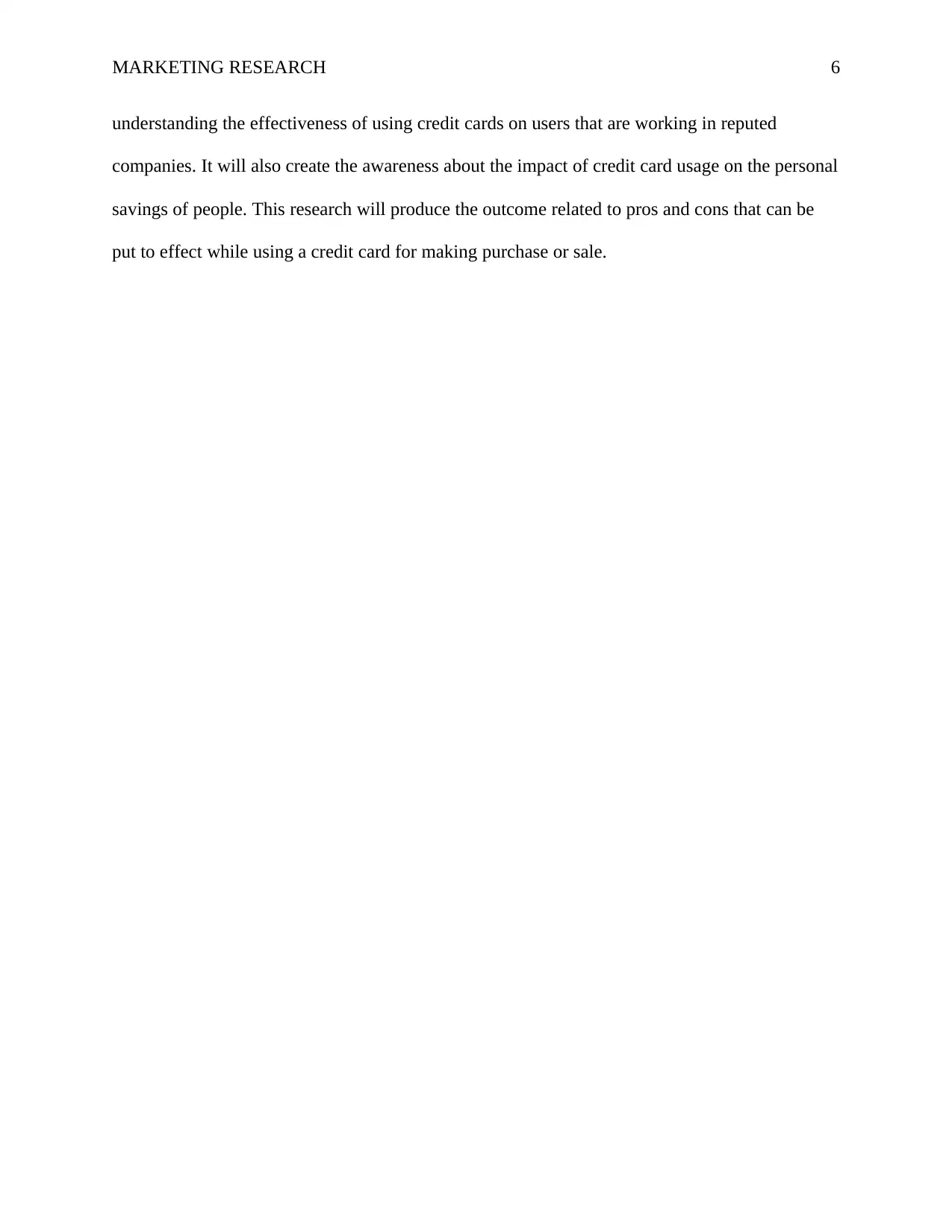
MARKETING RESEARCH 6
understanding the effectiveness of using credit cards on users that are working in reputed
companies. It will also create the awareness about the impact of credit card usage on the personal
savings of people. This research will produce the outcome related to pros and cons that can be
put to effect while using a credit card for making purchase or sale.
understanding the effectiveness of using credit cards on users that are working in reputed
companies. It will also create the awareness about the impact of credit card usage on the personal
savings of people. This research will produce the outcome related to pros and cons that can be
put to effect while using a credit card for making purchase or sale.
⊘ This is a preview!⊘
Do you want full access?
Subscribe today to unlock all pages.

Trusted by 1+ million students worldwide
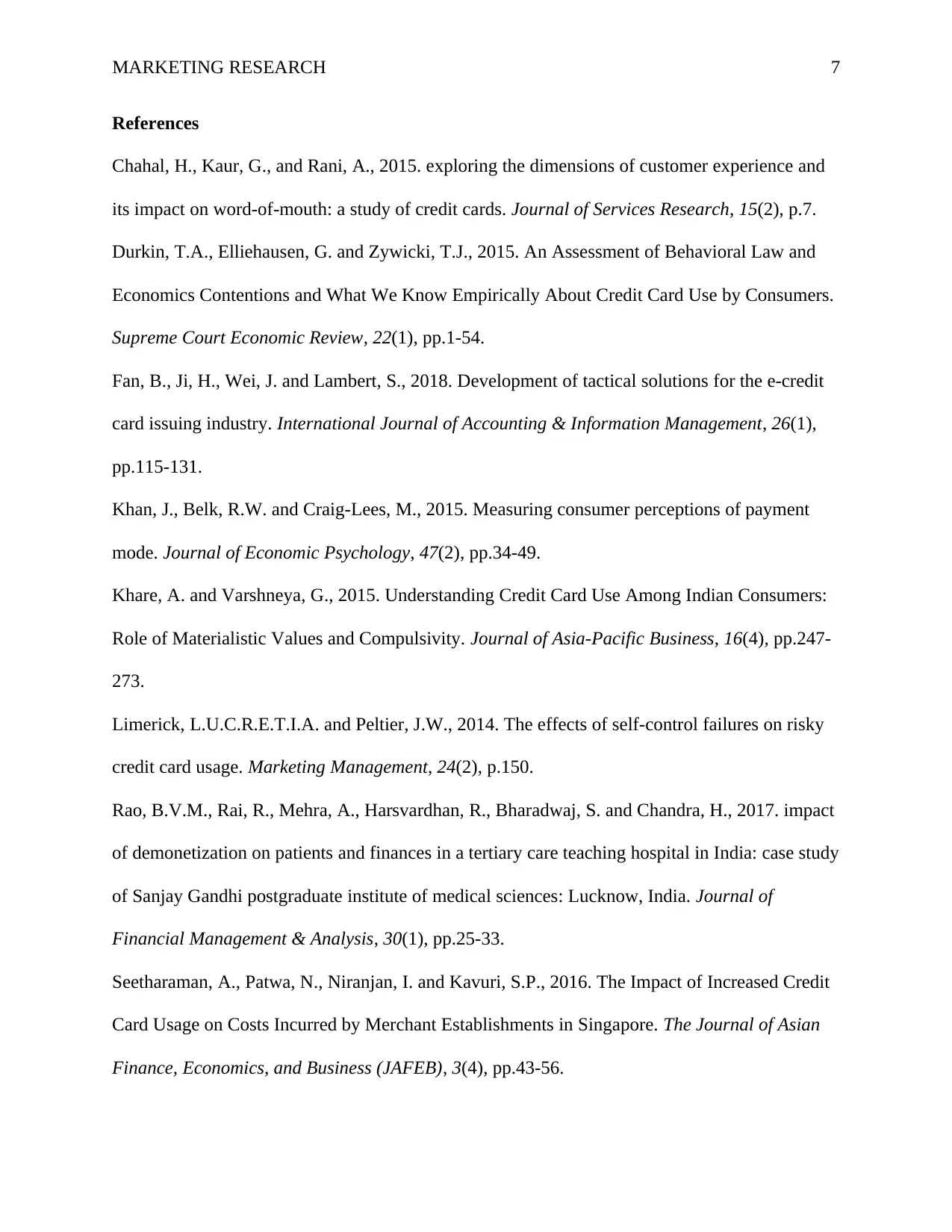
MARKETING RESEARCH 7
References
Chahal, H., Kaur, G., and Rani, A., 2015. exploring the dimensions of customer experience and
its impact on word-of-mouth: a study of credit cards. Journal of Services Research, 15(2), p.7.
Durkin, T.A., Elliehausen, G. and Zywicki, T.J., 2015. An Assessment of Behavioral Law and
Economics Contentions and What We Know Empirically About Credit Card Use by Consumers.
Supreme Court Economic Review, 22(1), pp.1-54.
Fan, B., Ji, H., Wei, J. and Lambert, S., 2018. Development of tactical solutions for the e-credit
card issuing industry. International Journal of Accounting & Information Management, 26(1),
pp.115-131.
Khan, J., Belk, R.W. and Craig-Lees, M., 2015. Measuring consumer perceptions of payment
mode. Journal of Economic Psychology, 47(2), pp.34-49.
Khare, A. and Varshneya, G., 2015. Understanding Credit Card Use Among Indian Consumers:
Role of Materialistic Values and Compulsivity. Journal of Asia-Pacific Business, 16(4), pp.247-
273.
Limerick, L.U.C.R.E.T.I.A. and Peltier, J.W., 2014. The effects of self-control failures on risky
credit card usage. Marketing Management, 24(2), p.150.
Rao, B.V.M., Rai, R., Mehra, A., Harsvardhan, R., Bharadwaj, S. and Chandra, H., 2017. impact
of demonetization on patients and finances in a tertiary care teaching hospital in India: case study
of Sanjay Gandhi postgraduate institute of medical sciences: Lucknow, India. Journal of
Financial Management & Analysis, 30(1), pp.25-33.
Seetharaman, A., Patwa, N., Niranjan, I. and Kavuri, S.P., 2016. The Impact of Increased Credit
Card Usage on Costs Incurred by Merchant Establishments in Singapore. The Journal of Asian
Finance, Economics, and Business (JAFEB), 3(4), pp.43-56.
References
Chahal, H., Kaur, G., and Rani, A., 2015. exploring the dimensions of customer experience and
its impact on word-of-mouth: a study of credit cards. Journal of Services Research, 15(2), p.7.
Durkin, T.A., Elliehausen, G. and Zywicki, T.J., 2015. An Assessment of Behavioral Law and
Economics Contentions and What We Know Empirically About Credit Card Use by Consumers.
Supreme Court Economic Review, 22(1), pp.1-54.
Fan, B., Ji, H., Wei, J. and Lambert, S., 2018. Development of tactical solutions for the e-credit
card issuing industry. International Journal of Accounting & Information Management, 26(1),
pp.115-131.
Khan, J., Belk, R.W. and Craig-Lees, M., 2015. Measuring consumer perceptions of payment
mode. Journal of Economic Psychology, 47(2), pp.34-49.
Khare, A. and Varshneya, G., 2015. Understanding Credit Card Use Among Indian Consumers:
Role of Materialistic Values and Compulsivity. Journal of Asia-Pacific Business, 16(4), pp.247-
273.
Limerick, L.U.C.R.E.T.I.A. and Peltier, J.W., 2014. The effects of self-control failures on risky
credit card usage. Marketing Management, 24(2), p.150.
Rao, B.V.M., Rai, R., Mehra, A., Harsvardhan, R., Bharadwaj, S. and Chandra, H., 2017. impact
of demonetization on patients and finances in a tertiary care teaching hospital in India: case study
of Sanjay Gandhi postgraduate institute of medical sciences: Lucknow, India. Journal of
Financial Management & Analysis, 30(1), pp.25-33.
Seetharaman, A., Patwa, N., Niranjan, I. and Kavuri, S.P., 2016. The Impact of Increased Credit
Card Usage on Costs Incurred by Merchant Establishments in Singapore. The Journal of Asian
Finance, Economics, and Business (JAFEB), 3(4), pp.43-56.
1 out of 7
Related Documents
Your All-in-One AI-Powered Toolkit for Academic Success.
+13062052269
info@desklib.com
Available 24*7 on WhatsApp / Email
![[object Object]](/_next/static/media/star-bottom.7253800d.svg)
Unlock your academic potential
Copyright © 2020–2025 A2Z Services. All Rights Reserved. Developed and managed by ZUCOL.



